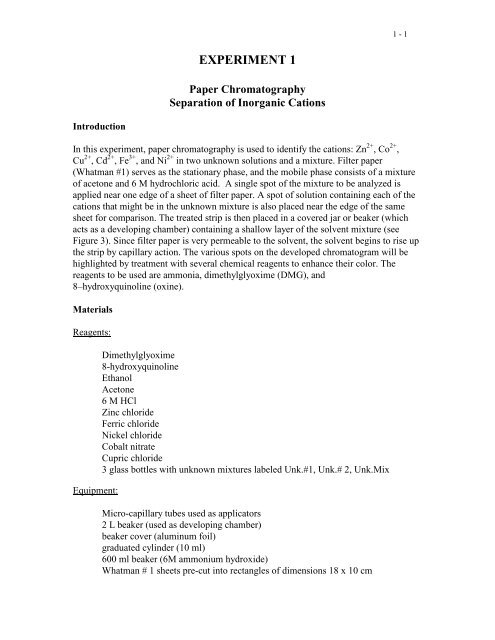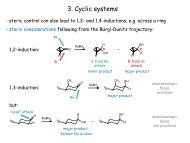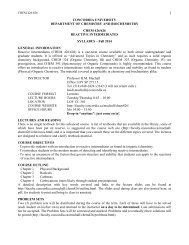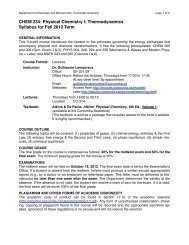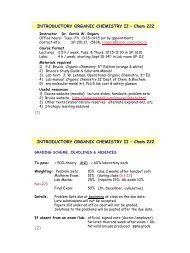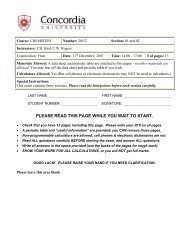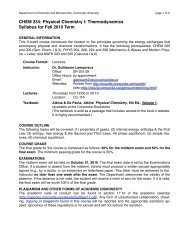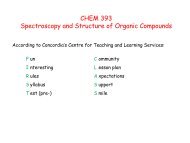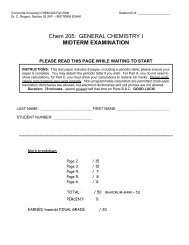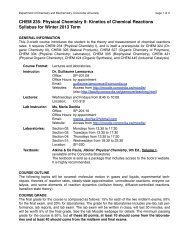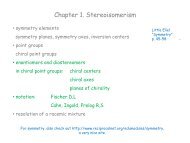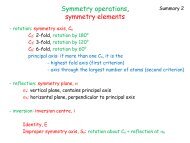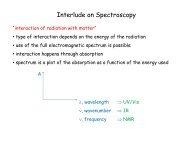Paper Chromatography Separation of Inorganic Cations
Paper Chromatography Separation of Inorganic Cations
Paper Chromatography Separation of Inorganic Cations
Create successful ePaper yourself
Turn your PDF publications into a flip-book with our unique Google optimized e-Paper software.
1 - 1EXPERIMENT 1<strong>Paper</strong> <strong>Chromatography</strong><strong>Separation</strong> <strong>of</strong> <strong>Inorganic</strong> <strong>Cations</strong>IntroductionIn this experiment, paper chromatography is used to identify the cations: Zn 2+ , Co 2+ ,Cu 2+ , Cd 2+ , Fe 3+ , and Ni 2+ in two unknown solutions and a mixture. Filter paper(Whatman #1) serves as the stationary phase, and the mobile phase consists <strong>of</strong> a mixture<strong>of</strong> acetone and 6 M hydrochloric acid. A single spot <strong>of</strong> the mixture to be analyzed isapplied near one edge <strong>of</strong> a sheet <strong>of</strong> filter paper. A spot <strong>of</strong> solution containing each <strong>of</strong> thecations that might be in the unknown mixture is also placed near the edge <strong>of</strong> the samesheet for comparison. The treated strip is then placed in a covered jar or beaker (whichacts as a developing chamber) containing a shallow layer <strong>of</strong> the solvent mixture (seeFigure 3). Since filter paper is very permeable to the solvent, the solvent begins to rise upthe strip by capillary action. The various spots on the developed chromatogram will behighlighted by treatment with several chemical reagents to enhance their color. Thereagents to be used are ammonia, dimethylglyoxime (DMG), and8–hydroxyquinoline (oxine).MaterialsReagents:Equipment:Dimethylglyoxime8-hydroxyquinolineEthanolAcetone6 M HClZinc chlorideFerric chlorideNickel chlorideCobalt nitrateCupric chloride3 glass bottles with unknown mixtures labeled Unk.#1, Unk.# 2, Unk.MixMicro-capillary tubes used as applicators2 L beaker (used as developing chamber)beaker cover (aluminum foil)graduated cylinder (10 ml)600 ml beaker (6M ammonium hydroxide)Whatman # 1 sheets pre-cut into rectangles <strong>of</strong> dimensions 18 x 10 cm
1 - 2Experimental Procedure1. You will be provided with a 10 x 18 cm piece <strong>of</strong> filter paper.2. To a 2 L beaker, add approximately 30 ml <strong>of</strong> the developing solvent (9:1 (v/v) <strong>of</strong>acetone / 6M HCl) so that the bottom <strong>of</strong> the beaker is covered to depth <strong>of</strong> a fewmillimetres. Cover the beaker with a piece <strong>of</strong> aluminum foil and let it stand to fill itwith the solvent vapours.Figure 1: Preparing for <strong>Paper</strong> <strong>Chromatography</strong> Analysis3. With a pencil draw a straight line 1.0 cm from the bottom <strong>of</strong> the paper (see Figure 1).Mark and label the points where you will apply each known solution: Co 2+ Cu 2+ , Fe 3+ ,Ni 2+ , Zn 2+ and the unknowns #1, #2 and mix solution. Pre-fold the paper every 3.0 cmas shown in Figure 2, and then flatten it out again temporarily before applying thesolutions.4. Apply each solution to its mark using a separate micro-capillary tube. (Boiling pointtubes can be used). Spot the paper very quickly and do not allow the spot to spread.Let the spot dry. Repeat the applications five times for each solution. Allow the spotsto dry completely before continuing.(The idea is to have an adequate quantity <strong>of</strong> each compound deposited in the smallestarea possible. You may wish to practice on a scrap <strong>of</strong> filter paper first.)
1 - 3Figure 2: Folding the paper for analysis5. Re-fold the paper so that it will fit into the beaker and stand up. Remove thealuminum foil from the beaker and carefully place the paper (spotted side down)inside it as in Figure 3. Replace the aluminum foil as soon as possible. (FROM NOWON, DO NOT MOVE THE BEAKER UNTIL YOU REMOVE THE PAPER).You will see the solvent climbing up the paper by capillary action: watch its leadingedge (the “solvent front”) which should stay fairly distinct, straight and horizontal.You will see some <strong>of</strong> the coloured compounds you spotted on the paper moving up atdifferent speeds behind the solvent front.Figure 3. Arrangement for <strong>Paper</strong> <strong>Chromatography</strong>
1 - 46. When the solvent front on the chromatogram is approximately 1 cm from the top,remove the paper. Mark the solvent front quickly with a pencil (before the solventevaporates and you can no longer see where it was). Allow the chromatogram to dry(you can use an oven set at 60 o C). Circle the visible spots and record their colours inon your report (Table 1). Not all the spots will be visible at this stage, the variouschemical treatments in the next steps will help show where they are.7. Working in a fumehood, place your dried chromatogram in a closed dessicatorcontaining a beaker containing 6M ammonia solution for 2 to 3 minutes. You may seefumes arising from the paper, the ammonia is neutralizing any residual HCl on thechromatogram. Circle any new spots that appear and note their colours. Record yourobservations in Table 1.8. In a fumehood, spray the chromatogram lightly with a 1% solution <strong>of</strong>dimethylglyoxime (DMG) - do not soak the paper completely. Circle and record thecolours <strong>of</strong> any new spots. If no new spots are visible, hold the paper over ammoniaagain as in step 7. Dry the chromatogram in an oven. Be careful not to char the paper.9. Finally, working in a fumehood, spray the paper lightly with a solution <strong>of</strong> 0.5% oxine(8-hydroxyquinoline) solution. Circle any new spots and record any colour changes tothe spots.10. Dry the chromatogram and calculate the R f values <strong>of</strong> each spot and that <strong>of</strong> yourunknown. Record your values in Table 2.
1 - 5Experiment 1 - ReportName_______________________________________Date________________________Unknown #’s__________________________________Questions:1. What is the structure <strong>of</strong> the stationary phase (cellulose)?2. What species are likely to exist in the moving phase (water/hydrochloricacid/acetone)?3. What is the nature <strong>of</strong> the attractions between the stationary phase (cellulose) and themoving phase (hydrochloric acid/water/acetone and the species being separated.4. What is the effect <strong>of</strong> the ammonia, dimethylglyoxime and oxine that leads to some <strong>of</strong>the colourless spots becoming visible?
1 - 6Results - Table 1Co 2+SpeciesOriginal Colour(driedColour afterammoniatreatmentColour afterDMG treatmentColour afteroxine treatmentCu 2+Fe 3+Ni 2+Zn 2+Unknown 1Unknown 2MixtureResults - Table 2Distance traveled by solvent front ____________ cmCo 2+Cu 2+Fe 3+Ni 2+Zn 2+SpeciesUnknown 1Unknown 2MixtureDistancetraveled by spot(cm)R f value** R f = Distance traveled by spot/Distance traveled by solvent front
1 - 7ConclusionsWhat ions were present in your unknown mixture?


